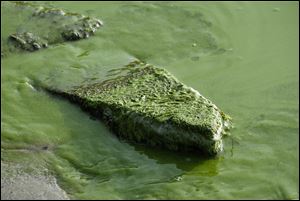
Key steps being taken to address harmful algal blooms
7/24/2018
Earlier this month, Gov. John Kasich issued an executive order meant to improve the health of Lake Erie.
There is a push right now to address the harmful algal blooms that are sickening Ohio’s lakes and rivers, and I’m confident that the Administration, state agencies, agriculture and environmental groups like The Nature Conservancy together can tackle the challenge—if we build on progress.
Unfortunately, Ohioans have become accustomed to hearing about harmful algal blooms in the state’s lakes and waterways, and this time every year anxiety grows over the issue. I just returned from a family camping trip to Kelley’s Island, where it was easy to imagine a bloom coming within days given the very hot temperatures and little wind. It’s not a question of if there will be a harmful algal bloom, but rather when, and how large and toxic it will be.
On July 12, the National Oceanic and Atmospheric Administration’s (NOAA) announced its prediction that this summer we’ll see a harmful algal bloom that is smaller than in 2017 but larger than in 2016. The size of a bloom, however, is not necessarily an indication of toxicity.
It was good news, then, when on July 11 Gov. John Kasich signed SB 299 into law and issued an executive order to initiate new action to further reduce nutrient runoff in Lake Erie’s western basin. The executive order asks the Ohio Soil and Water Conservation Commission to consent to designating watersheds with the highest demonstrated levels of phosphorus as “Watersheds in Distress”. Once designated, state agencies would propose rules for nutrient management plans to reduce all sources of nutrient runoff from farms. This is a practical approach because it targets solutions where the problem is acute, and allows nutrient management plans to be tailored to individual farms and circumstances. The Commission, however, voted to table the decision at their July 19th meeting until a subcommittee considers questions about recent data and impacts to farmers.
We urge them to do so quickly.
SB 299 is complementary to the executive order, providing additional resources to farmers, Soil & Water Conservation Districts, and partners to develop nutrient management plans, comply with regulations, and engage in actions to reduce phosphorous runoff. SB 299 represents a significant down payment and establishes a framework for increased funding and successful implementation of nutrient management plans.
In addition to encouraging long-term funding, The Nature Conservancy is working on the ground with agriculture, universities, and government partners. The 4R Nutrient Stewardship Certification Program, developed by leading agribusinesses and The Nature Conservancy, provides an opportunity for agricultural nutrient service providers to adopt best practices, using the Right Source of Nutrients at the Right Rate and Right Time in the Right Place. Nearly three million acres, and counting, are enrolled in this voluntary statewide program. This program is relatively new, but research shows that the practices are starting to work.
We’re also working to identify and demonstrate best practices to help slow water as it rushes off fields during significant rain events. By diverting runoff to small filters and recycling systems at the edge of a field, and by reintroducing small floodplains into drainage ditches, we can capture nutrients before they’re flushed into Lake Erie’s tributary waters. Funds paid to landowners to voluntarily restore a well-targeted one percent of the Western Lake Erie Basin to floodplains and riparian corridors would provide outsized value in absorbing excess nutrients and sediments.
Let’s continue to increase our investment in long-term funding and practical and effective policies for solutions that address harmful algal blooms. Future generations deserve to enjoy, rather than worry about, their streams and lakes.
Bill Stanley is the interim state director and director of conservation for the Nature Conservancy in Ohio.